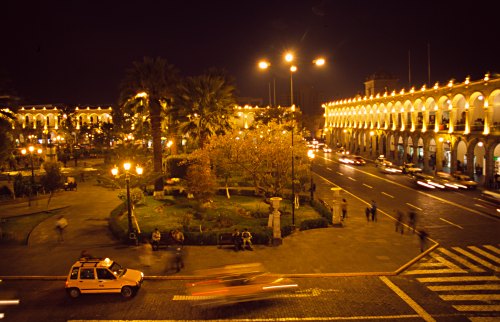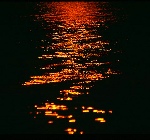Capturing Movement
OK, I already wrote a little bit about motion blur occurring when shooting from a car, plane or train.
Of course, the same phenomenon can occur when you hold the camera perfectly still, maybe using a tripod, but one of the objects in the picture moves while you press the button.
Again, very often, this results in a useless photo.
On the other hand, it is possible to use this to great effect.
Let us first consider the following photo of the Plaza de Armas in Arequipa.
I’m not quite sure whether I Like the effect here, but it is a good demonstration:
So, what happened? I took this shot from a tripod. The Plaza, the car on the left, trees and buildings are perfectly sharp. The car in the foreground, however is moving quickly towards the right. It is completely blurred.
Note how the red and white lights form a sort of line. Had the exposure been even longer or the movement a bit faster, the car would not be recognisable as such anymore.
This is what happened to the cars on the right hand side which are reduced to lines of light. For a comparison, have a look at the lanterns of the plaza and the colonnades on the right.
Also interesting: there are some people sitting on benches while others are moving around. The ones on the benches are sharp, the ones who are moving are converted to “ghosts” and shadows, their level of abstraction being an indicator for their speed of movement.
OK, this was an experiment. The next shot was absolutely meant to produce an abstract “painting” of movement rather than a recognisable portrait:
This is a dancer in Kandy, Sri Lanka. I took quite a few pictures on this occasion and this one was meant to convey a sense of movement.
I did not use a short exposure time to freeze movement here, nor a flash or fill-flash. Note how the artificial light gives the picture a yellowish cast which I quite like here, so I didn’t correct for it afterwards.
Now, what would happen if you combine a long exposure time with a little bit of fill flash? Obviously, the colour cast will be reduced and some parts of the dancer would appear sharp. This is exactly what happened in the next shot:

I hope, this illustrates some of the possibilities!
Actually, motion blur may be so desirable as an effect that sometimes a photographer will use a neutral density filter to create a motion effect even in broad daylight. You may have come across some beautiful shots of waterfalls, mountain brooks and lakes appearing incredibly soft and “unreal”.
You can try this yourself with a camera on a tripod in the morning or evening or using a filter to reduce the light and increase exposure time.
One good project to learn more about the different ways of capturing the movement of water would be to shoot a simple fountain somewhere, using a tripod and different exposure times. You’ll notice that with very short times, you will see individual drops of water that you couldn’t distinguish with your eyes alone, while long exposure times will give the above motion blur effect.
While you’re at it, try using a fill flash.
Maybe I’ll write something on photographing water lateron...


